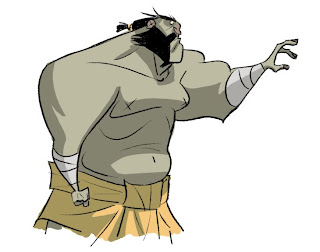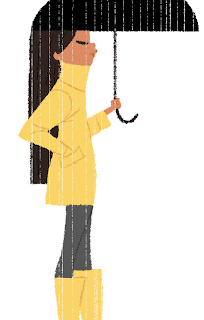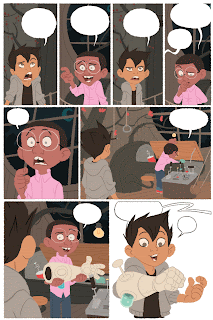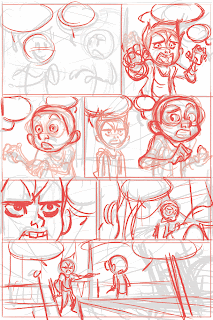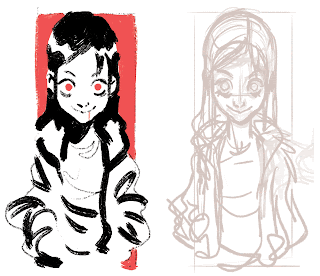RAD SECHRIST INTERVIEW
Storyboard Artist at DreamWorks Animation, Comic Book Artist, Illustrator, And Designer
Monday, February 8, 2010
BROUGHT TO YOU BY THE CHARACTER DESIGN BLOGSPOT
IF YOU WOULD LIKE TO SEE MORE INTERVIEWS GO TO THE HOME PAGE BY CLICKING HERE
Rad Sechrist Interview
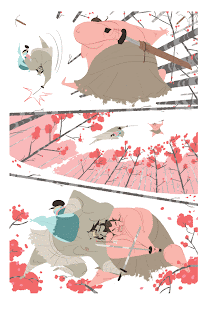
Tell me a little bit about yourself, about your life? Where did you go to school, and what classes did you study? What helped prepare you to become the artist that you are today?
I studied and graduated with a mechanical engineering degree from UCSB. After I graduated, I studied art at schools like Watts Atelier, L.A. Academy of Figurative Art, Concept Design Academy, 3 Kicks Fine Art Studio, and the Animation Union. I still take as many classes as I can each term. I learned to draw cartoons by pausing Disney movies and copying the characters and just trying to figure out how they drew them.
How do you go about story boarding, and what goes through your mind, from start to end?
If it’s an action scene, I find it helps to just board straight through. Sometimes the camera will end up in really interesting places that will help me think of the next shot - something I wouldn’t really be able to plan out. It also helps to not be precious with the drawings. I try not to spend more than a minute on a drawing so that I’m not attached to it and I’m able to throw it away if I want, and try several different things. I know some people sit and play the scene out in their head before they draw it, but I like to just start without a plan and almost do slow motion improv with action scenes. Once I get the scene started, later that night, some idea will pop into my head as I go to sleep. I write it down for the next day at work. I work pretty organically. One idea may not fit here, but then it fits over there. I try a lot of things without much care if I use it or not. Sometimes to help me start I just draw completely random shots of the characters and the location.
If it’s more of an acting scene I find it helps to do a bit more planning. I might want to know when I am going to have a close up for certain lines and so on. I might do little thumbnails on the side of the script and write down bits of dialogue that I might want to use. Overall though, I still keep the process very organic. If I had something planned out, but then when I draw it, I think of something else, I try it. Again, I find it really comes down to a slow motion improv sort of a thing. Sometimes I’ll draw two characters saying a line, but then I look at the drawing and it just looks like it would lead to something else that I hadn’t planned for. The key is to draw quickly and clearly. Quickly, so that I feel free to try lots of different things, and clearly, so that I don’t have to waste time going back to clean it up.
What is a typical day for you, and who are the people you work with?
I get to work early so I can have breakfast, hang out with some friends, drink coffee and talk about the movies for a bit. Then I head up to the office. I always start out with at least an hour of warm up studying. I do studies from movies because I like to see how they handle the camera. I also do drawing studies of anything I had trouble with the day before. For instance, if I had trouble drawing a hand the day before, I go find a hand like that somewhere and do studies. If I don’t have a busy day, I’ll spend a lot of time doing studies.
What are some of the things that you have worked on?
I’ve worked on two movies here at DreamWorks Animation. Both are still in development so I can’t really talk about them. Before that, I worked for a little bit at Sprite Animation doing character design, and before that I did freelance comics, character design, and illustration work.
Who are some of your favorite storyboard artists?
The talent here is amazing. My jaw hits the floor every time I look over someone’s shoulder. It’s actually kind of strange that some of these people don’t have blogs and nobody knows who they are outside of the industry. Off the top of my head, some of my favorite board artists are Toby Shelton, Tron Mai, Philip Craven, Rodolphe Guenoden, Alessandro Carloni, Tom Owens, Dave Pimentel, Catherine Rader, Tim Heitz, and Andy Schuhler, but I know I have so many more.
What are you working on now? (if you can tell us)
I’m working on a film that’s currently in development here at DreamWorks Animation, but I can’t give any more details than that. I’m also working on some short stories for anthologies – one of them being Flight, which I’ve had the privilege of contributing to sporadically over the past several years. I am also teaching a class at the Concept Design Academy.
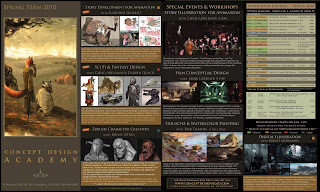
Could you talk about your process in coloring your art, as well as the types of tools or media that you use?
I use Photoshop for everything. I don’t really ever draw on paper anymore outside of life drawing classes and doodles. In Photoshop, I use a variety of brushes that a lot of other artists use at the studio. I don’t really know how to make brushes from scratch. For color, I try to pick a dominant color for a page and then push all the other colors towards that color. I just play with the colors until I like them. Sometimes I think about the colors in terms of “if I would want this on a t-shirt.”
What part of story boarding is most fun and easy, and what is most hard?
The fun part in terms of drawing is the motion - when you flip through the panels and it looks like its moving. One of the hardest things for me is getting women’s faces to have emotion. When I try to draw intricate eye shapes, it’s really hard to get expressions. As far as the writing goes, I like writing comedy. It’s nice to be laughing at your job all day long. Writing a dramatic scene is much harder.
What are some of the things that you do to keep yourself creative?
Most of my drawing time is spent doing studies. I spend very little time just purely being creative. I don’t really worry about it. If I feel creative, I’ll draw something. If not, I’ll do studies.
What are some of your favorite storyboards sequences you have seen?
I like Philip Craven’s training sequence in Kung Fu Panda – the part with the chopstick fight.
What is your most favorite subject to draw? And why?
I don’t really have a favorite subject, but I like drawing characters. I tend to swing on a spectrum from really cartoony stuff to really realistic stuff. There are times when I only draw one or the other, but it always seems to swing back and forth. I try to tell myself that I should only draw cartoony stuff because that is what I like to look at, but then I find myself drawing realistic stuff.
What inspired you to become an Artist?
There was a rough Freddy Moore drawing of Donald Duck in The Illusion of Life that I saw as a kid. I just had to know how to do that. Even when I was in engineering school, I drew all the time. I didn’t know I could have a job drawing, since 2D animation had slowed down, but I was still driven. There was just something about that Donald Duck drawing.
What are some of the neat things you have learned from other artists that you have worked with or seen?
So many artists at the studio have been kind enough to share their drawing tips with me, so there’s no way for me to narrow them all down. One thing I noticed is that some people draw very slowly. Sometimes I look at a rough drawing and it just looks like they drew it fast, but then when I watch them, they draw it really slowly and constantly hit the “undo” button. I was shocked by that. Some artists do draw fast, but for the most part, they all draw much slower than I was expecting.
What are some of your favorite websites that you go to?
I just browse through all the links on my blog each morning and see if I can find some new links to add.
What wisdom could you give us, about being an Artist? Do you have any tips you could give?
It’s so personal. I would say, just take everything everyone says with a grain of salt. If you like drawing a certain way and someone tells you to draw another way, just know that you don’t always have to listen to them. Just do what you enjoy. I like drawing in sort of a Disney style, and I really don’t care what people think about it - I just like it. I also like taking life drawing classes and painting classes. I basically just do what I like, not what a teacher tells me I should like.
If people would like to contact you, how would you like to be contacted?
My email is radsechrist@hotmail.com
Blogs: http://www.radfordsechrist.blogspot.com/
http://radhowto.blogspot.com/
Finally, do you have any of your art work for sale (books, prints, or anything) for people that like your work can know where and when to buy it?
I teach a story class here: http://www.conceptdesignacad.com/
And I worked on Flight vol. 1, 2, 3 and 6.
Subscribe to:
Comments (Atom)





